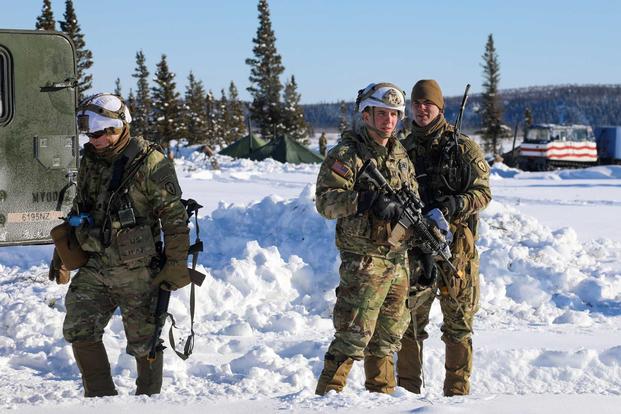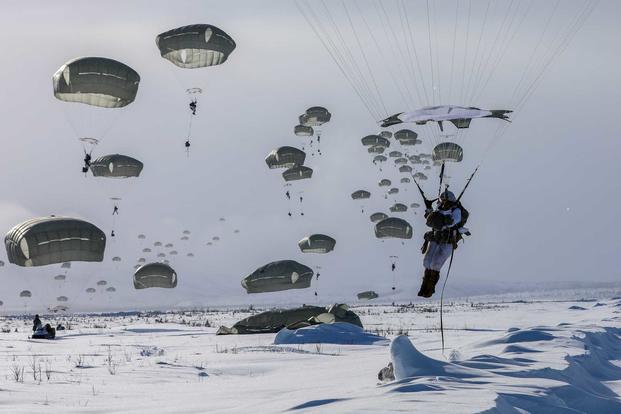
'It's Lethal Here': Army Aims to Master the Arctic, Where the Environment Is the Enemy

FORT GREELY, Alaska -- In the frigid temperatures of late winter Alaska, a soldier's equipment needs to work in negative 65 degrees. Soldiers stationed in Alaska must carry more gear than the grunts in traditional units, layers upon layers of clothing to protect them from the extreme conditions. Otherwise simple combat training is against a real-world enemy -- the environment. Any simulated adversary is only a secondary threat.
Everything is slower with Arctic warfare. Soldiers must strap snowshoes onto their "bunny boots," which are much heavier than standard-issue boots, and trek through waist-deep snow and slippery ice. Squads will drag a sled carrying tents and the gear to heat them, along with fuel, water and calorie-dense food rations made specifically for units operating in the extreme cold.
Simple survival is not a concern in most military training, but subzero day temperatures and plunging night temperatures make even the most mundane Army task a huge undertaking in the Arctic.
Read Next: Texas Replaces National Guard Chief After String of Reports About Border Mission Problems
It's an area of combat that has suddenly gained greater importance to military planners and strategists as U.S.-Russia relations fall to lows unseen since the Cold War and the Pentagon contemplates how to defend terrain from forces separated only by ice over the top of the globe.
"Number one is survival," Lt. Col. Matthew Chase, commander of the 70th Brigade Engineer Battalion, told Military.com. "You can normally just go into combat operations. But step one is establishing life support, such as building tents and sources of warmth. The force that can figure out how to survive in this environment, that can just sustain itself, is probably the force that wins."
Soldiers must be much more meticulous about how they pack their rucksacks and dress. Exposed skin can quickly become devastating in this climate. In the Army's Cold Weather Leaders Course, which earns soldiers the "Arctic" tab, instructors showed images of a soldier who took his gloves off occasionally to operate a radio. Even those brief, but numerous exposures to the freezing air can lead to finger amputations. Multiple noncommissioned officers told Military.com that no one in Alaska will correct a soldier for putting their hands in their pockets -- a move that usually draws a quick scolding from senior enlisted leaders at other installations.
Soldiers often pack several types of gloves, including thick mittens, some with a trigger finger; and more dexterous contact gloves to operate equipment. Brief skin contact with metal can freeze fingers in less than five seconds. On top of that, troops wear a thin white jacket and pants over their camouflage uniforms to better blend into the snow.
To figure out what new equipment may be needed and to stress-test doctrine, Army units in Alaska are in the midst of a major training exercise consisting of about 8,000 soldiers, including some special operations forces and Canadian paratroopers. The training event comes exactly a year after the Army published its Arctic strategy, and leaders hope to make it a combat training center, or CTC, rotation for its forces.
CTCs are weeks-long training events the Pentagon uses to simulate a combat deployment as best as possible. Typically, units would mobilize to the National Training Center, or NTC, at Fort Irwin, California, or Joint Readiness Training Center at Fort Polk, Louisiana. Those rotations certify that a unit is fit for deployment abroad.
A highly specified CTC for a small group of specialized troops would be a bold and unprecedented move. But leaders argue that it's expensive and can take months of planning to move all its gear, vehicles and soldiers from Alaska to the California desert or Louisiana swamps, and that it makes no sense for Arctic soldiers to invest a lot of training in those environments. Far down the road, it is possible a CTC in Alaska could serve as a training ground for other units that specialize in cold environments, such as the 10th Mountain Division or the Vermont National Guard's 86th Infantry Brigade Combat Team.

"There's a cost and time with going there," Maj. Gen. Brian Eifler, commander of U.S. Army Alaska, told Military.com. "Here, we can deploy out in the middle of this exercise."
That push from Pentagon planners and Capitol Hill comes amid climate change melting the ice in the Arctic region. More open waters would make it easier for ships to navigate -- namely vessels from China and Russia. Both countries have expressed interest in the region.
But the focus isn't strictly to defend Alaska from invaders. Any foreign force aiming to capture Alaska would have to navigate hundreds of miles of frozen terrain and would likely have to fight off starvation and freezing to death. Instead, senior leaders point to the need for strong doctrine, given past U.S. battles in Korea, Italy and Germany in which troops faced dangerously low temperatures.
Many troops have makeshift necklaces with chapstick and a lighter attached, and dress in multiple layers of cold weather clothing. They have to pack a huge supply of batteries to power their night vision, radios and other gear, given that power sources tend to lose their charge in the cold. Often, they'll have some of those batteries in a makeshift pocket sewn into their clothing to employ body heat to keep them warm and operational.
Small heated tents are critical for a soldier's survival. But at the two-week Cold Weather Leaders Course, troops are also taught how to build makeshift shelters out of tree branches, or to dig a small cave into a mound of ice to survive the night. Those shelters, where two soldiers sleep close together for body heat, can block the frigid wind.
"This teaches them to not be so dependent, to make them understand if they don't have a tent, they won't die," said Staff Sgt. Jordan Weeg, an instructor at the school.
But it's unclear if Alaskan troops are fully equipped for their mission. Soldiers often operate in older generation Strykers, with some leaders expressing skepticism about whether the vehicles are practical in the Arctic or if they might need customizations to work in extreme conditions.
Yet in the early stages of revamping Arctic training, it can be a tall order for the Pentagon to invest in hyper-specific equipment for just one set of soldiers -- despite them belonging to hyper-specialized units. Fort Wainwright, where Strykers are usually kept, has few heated garages or indoor motor pools. That constant exposure to subzero temperatures can lead to numerous mechanical issues and be a major hurdle to basic maintenance.
The new focus on the Arctic is part of a larger Army effort to shift away from counterterrorism to building its forces to fight more conventional enemies. The Army's Arctic strategy aims to reestablish the service's ability to operate in extremely cold conditions, after those skills took a back seat at the end of the Cold War and post-9/11 wars, which soldiers, even those based out of Alaska, largely fought in the desert and extreme heat.
"The [Global War on Terror] replaced a lot of the Arctic expertise, and that was the reason we lost a lot of our expertise in the past 20 years," Command Sgt. Maj. Alex Kupratty, the acting command sergeant major for the 4th Infantry Brigade Combat Team (Airborne), 25th Infantry Division, told Military.com. "We were able to identify huge, significant gaps when it came to Arctic expertise. So we're in a race to get proficient again. It doesn't happen overnight; it takes years."
Army leaders are aware Alaska isn't for everyone. Instead of installations to which any soldier can be randomly assigned, the service is aiming to make Alaska a more exclusive club composed of volunteers. Now, soldiers enlisting into the force can elect to be stationed in the state, which can be attractive to troops who like outdoor winter recreation. Leaders in Alaska are also trying to retain soldiers who want to stay instead of losing them in involuntary reassignments. It can take years for a soldier to adequately learn the environment in the Arctic, a talent leaders don't want to lose.
"What I want is that confidence to operate in these cold temperatures and thrive. We need to be able to survive. If you don't get that right, it doesn't matter what the enemy does. It takes time and effort to train for here," Eifler said. "It's lethal here. It's a great challenge; it's not for everyone. But we're trying to bring people in who want to be here."
-- Steve Beynon can be reached at Steve.Beynon@military.com. Follow him on Twitter @StevenBeynon.